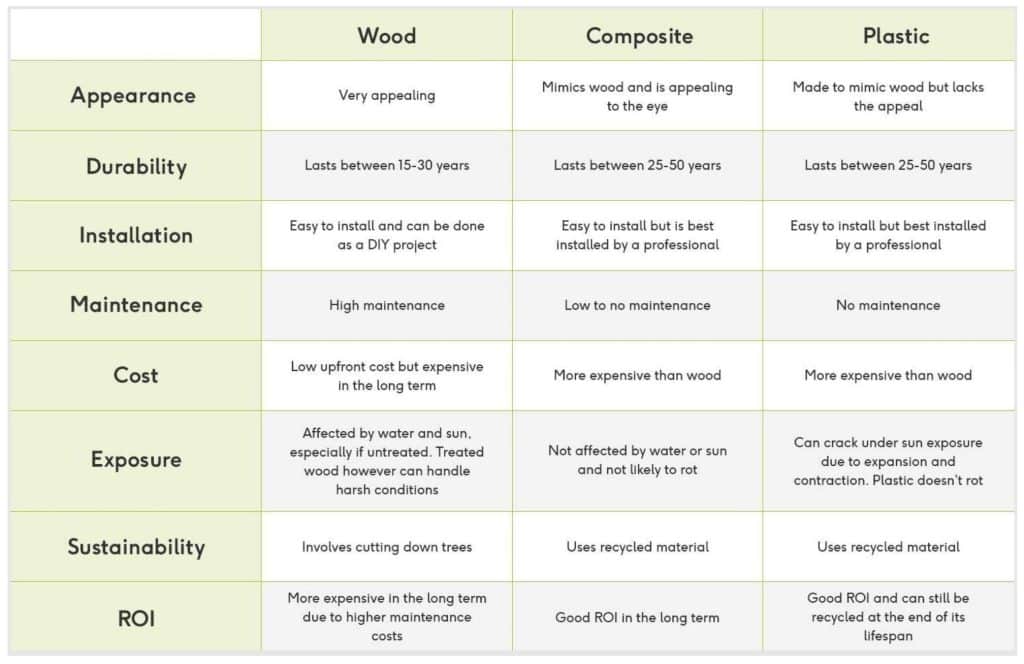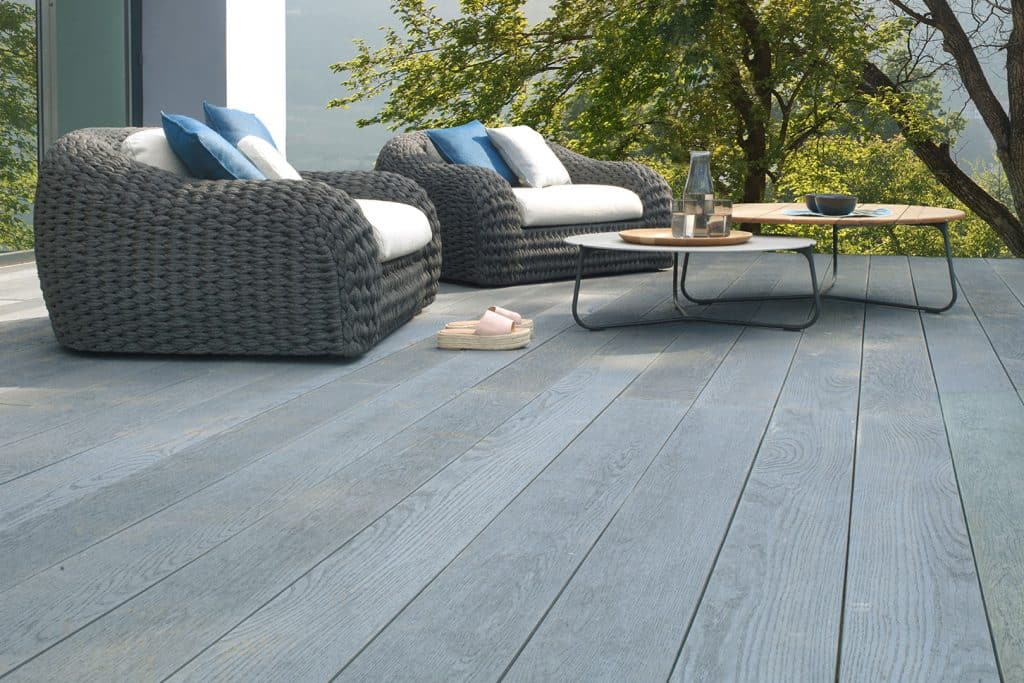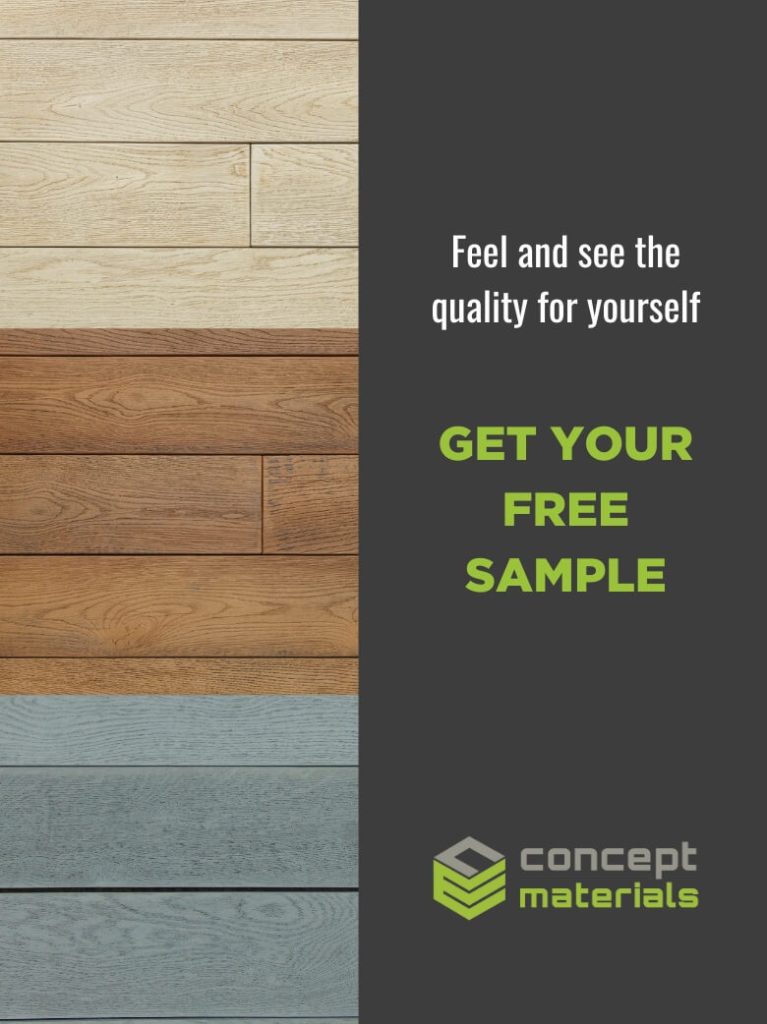If your home has an outdoor space, your living area doesn’t need to end at the front door. You can extend it outwards and create a space you can conveniently and efficiently use all year round. One of the best ways to do this is by building an outdoor deck. It can be a practical way to add space to your living room while creating a smooth transition between your indoor and outdoor areas.
According to one survey, 36% of Australians are looking to build a deck or an outdoor floor to extend their living spaces. But while a deck is a good option, there’s a lot to consider when building one. Traditionally, the options were limited to wood, but now there are plenty of options to choose from.
In this guide, you’ll learn what to consider when purchasing deck materials and the pros and cons of each one. Let’s get started.
Types of Decking Material
Essentially, there are three types of deck materials available: wood decking, composite decking, and plastic decking. In this section, we’ll elaborate on each option to help you make a more informed decision on which material would be more suitable for your decking project.
Wood Decking
As one of the most popular decking materials, research shows that the wood decking industry is expected to keep growing globally, including in Australia, reaching significant figures by 2027.
Wood has often been a preferred choice because of its look and feel. For many homeowners, nothing can quite compare to it.
One of the most common types of wood deck materials available is pressure treated wood. This natural wood is treated with chemicals to make it insect-, mold-, and rot-resistant. The chemicals used for treating wood include:
Water-based chemicals: This is a class of wood preservatives primarily used when you need the wood to look clean or to paint it. They leave no odour on wood and aren’t a fire hazard. The water-based chemicals used are:
- Copper Azole (CA): Copper azole is a mixture of copper and fungicide. Sometimes, boric acid is added as an ingredient as well.
- Alkaline Copper Quaternary (ACQ): This preservative contains copper oxide and a quaternary ammonia compound to protect wood against rot and decay.
- Micronised Copper Azole (MCA): Micronised copper azole, together with micronised copper quaternary (MCQ), are basically minute copper particles used to prevent wood from rot and decay. These particles aren’t chemically bound but rather lodged into the holes in the wood structure due to their particularly small size. Typically, micronized copper uses copper than other preservatives.
Oil-based Preservatives: Wood can also be treated with oil-based preservatives. The oil makes the wood waterproof, protecting it from weathering and insect infestation. The two main types of oil-based preservatives are:
- Copper Naphthenate: Wood treatment plants have used this oil since the ‘40s and can be used in water preservatives as well.
- Pentachlorophenol (PCP): This oil is used to disinfect and repel pests from the wood. It can be applied through a pressure process or simply soaking or spraying the wood with the formula.
Other oils, like Creosote which were originally used to treat wood for external residential use, are now only used for things like rail wood treatment. Pressure treating wood helps to enhance natural longevity. There are various wood grades after treatment, including:
- Premium: This is the top grade with a high appearance consistency and has little or no defects.
- Select: This is another high-grade wood with a minimum of 1/12 gran slope. It has few defects with encased knot sounds. It also has a consistent appearance.
- Number 1: This is a mid-range grade suitable for 5/4 decking. The boards can only have one hole every 3 feet and knots 2 ¾ inches or smaller.
- Number 2: The minimum grain slope is 1/8, and the boards can’t contain splits that are bigger than 1 1/5 times of the board’s width. They can have holes after every two feet.
- Number 3: This is the lowest grade and may not be suitable for decking at all.
The highest grade is the best. This is because it offers a smoother grain with minimal to no knots. Working closely with local suppliers, builders, or architects will help you decide on the most appropriate grade for your budget and needs.
Pros and Cons of Wood Decking
Wood might be a popular decking material and is loved by most for its beauty, but it can come with some pros and cons:
Pros
- Cost: Compared with other decking materials, wood decking is cost-effective. Natural wood is the cheapest, while pressure-treated and hardwood can cost more. The cost of labour is also lower due to ease of installation.
- Installation: Wood is quite adaptable. Cutting and shaping it in various layouts is easy during installation.
- Appearance: Wood is generally the most appealing deck material as it gives out a naturally rustic look. You can also paint it to style as per your liking if you don’t like the natural hues.
Cons:
- Maintenance: Wood requires regular maintenance to keep it in good condition. You’ll need to resurface, stain, or paint it from time to time.
- ROI: In the long run, installing and maintaining a wood deck could be more expensive than synthetic materials. The cost of buying paint, stain, or sealants, plus the cost of labour over the years, can quickly add up to the initial cost and maybe surpass other decking alternatives like composite and plastic decking that are low maintenance.
- Sustainability: Building a wood deck requires trees to be cut down. This impacts natural resources and the environment as a whole, unless it comes from tree farms specifically.
- Exposure to elements: While hardwood and pressure-treated timber can last for a very long time compared to natural wood, timber is generally unsuitable to use near water bodies or water plants as it’ll get damaged with time. Too much exposure to the sun can also lead to faded hues, shrinking, warping, and cracking.
Composite Decking
As ideal as building a wood deck may sound, the work and the costs of keeping it in good condition can be challenging. But because homeowners still love wood, manufacturers have devised a way of serving homeowners the natural timber look through composites. They have a longer lifespan and are low maintenance.
Composite decking’s global market value is growing steadily and is a worthy alternative to wood decking material. The manufacturing process involves combining products with different chemical and physical properties. This improves the strength of the base materials. The common components in composite decking are:
- Wood and plastic: Some manufacturers use a blend of wood fibres such as sawdust and wood chips mixed with recycled plastic to create a wood-like composite material. This material will look and feel like wood, and comes in a wide range of colours. The wood and plastic fibres are collected waste from the product manufacturers. This is an excellent way to reclaim wood and plastic waste, keeping it away from landfills. The composites also melt at a lower temperature than plastic, reducing energy use.
- Wood and resin: Same as the material above, manufacturers will use wood fibres and resin to create a stronger material that offers better protection from weather damage. Similarly, the use of wood and resin is sustainable as minimal trees are harmed. It helps in reducing wood waste through recycling.
- Non-wood and non-plastic materials: Some manufacturers also make composite decking material from polyurethane, a high-performance rubber, combined with mineral fibres and coated with elastane. This is the manufacturing process used in manufacturing Millboard decking material. This makes non-wood and non-plastic materials both highly durable and the most eco-friendly building materials.
There are two main types of composite decking to choose from:
- Capped: This decking board is coated with a tough material, making it more resistant to stains, scratches, and wear. The coat also means higher resistance to damage by ultraviolet rays, reducing the rate of fading and making them last longer. Capped boards are better for decks that see high traffic or are prone to damage by children or pets.
- Uncapped: These composite boards have no coating and tend to be cooler than capped boards. If your deck is constantly exposed to the sun, they’ll provide better foot comfort. However, they absorb stains more easily than capped boards.
Pros and Cons of Composite Decking
Composites offer more benefits compared with wood decking but it also has some downsides.
Pros:
- Highly durable: The combination of different materials, brings out the strongest qualities in the base elements to the final product. This means your deck will be stronger to withstand damage from the weight of furniture, people, and harsh weather elements.
- Low maintenance: You don’t need to paint or stain your deck to keep its look or make it last longer. Some composite decking materials like Millboard are practically maintenance-free.
- No splinters: Splinters occur when a wood deck continuously absorbs and loses water, causing defects. A composite deck will give you a wood-like look without splinters.
- More colour choices: Unlike wood, composite decks come in numerous colour choices. You can get your decking planks in tan, brown, grey, or white. You can also get some patterns that successfully mimic the wood grain.
- Environmentally friendly: Composite decking materials are made from recycled materials, making them more sustainable. Instead of the destruction of natural resources such as forests, you’ll be helping to clean up and save the environment.
Cons:
Cost: You can expect to pay more for composite decking than you’ll pay for wood. If you want to build or renovate your deck on a budget, this can be a challenge.
Plastic Decking
Another option is plastic decking. While some composite materials have some plastic elements, this material is primarily plastic categorized into:
Polyvinyl chloride (PVC): This material creates long-lasting, low-maintenance decking material. It can also be made to mimic wood just like composite materials and contains additives that make it insect- and rot-resistant.
High-Density Polyethylene (HDPE): This material is also fully plastic and can be made to look like natural wood with its different colours and grain patterns. However, it doesn’t produce toxic chemicals during its production.
Generally, plastic decking is a resilient material that can build beautiful decks without the vulnerabilities of timber. It also has more colour options to choose from.
Pros and Cons of Plastic Decking
Plastic decking has its upsides and downsides, so it may not be ideal for everyone.
Pros:
- Maintenance: Plastic decks are relatively low maintenance. You don’t need to do much to keep them looking good.
- Longevity: This type of decking can last between 25 and 50 years.
- Environmental impact: Because most plastic decking comes from recycled materials; it helps turn waste into product. In addition, you can recycle it again when it completes its lifespan.
- ROI: Because it can last for a long time and is practically maintenance-free, it can give a good return on investment.
Cons:
- Appearance and aesthetics: Although manufacturers try to make plastic decking look like natural wood, the effort hasn’t been very successful as it still looks more synthetic than wood.
- Feel: Typically, plastic gets extremely hot in the sun and can be uncomfortable walking barefoot on. Plastic also expands and contracts, which can cause random, unneeded noise.
- Cost: Plastic is one of the more costly decking materials, so you should be ready to spend more than you would with wood.
Deck Material Comparison

Final thoughts
When choosing materials for building or renovating your home it involves balancing between picking qualities that create beauty and those that enhance longevity, you also have to consider the material’s sustainability, deck usage, exposure to elements, costs, and the eventual ROI. However, no matter what deck materials you use, you’ll still end up with a beautiful deck ready for entertaining.








